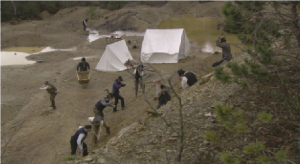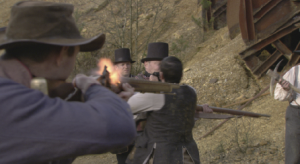Revisiting the ghosts of Duffy’s Cut
Published in 18th-19th Century Social Perspectives, 18th–19th - Century History, Editorial, Issue 3 May/June2013, Volume 21

Above: Irishmen at work at Duffy’s Cut, Pennsylvania, and (right) the gunmen allegedly hired by fearful locals to finish them off—stills from the Tile Films follow-up documentary, which will be broadcast on PBS in the US on 8 May and in autumn 2013 on RTÉ.
John Ruddy was allegedly murdered or died of cholera in the US in 1832, at the age of eighteen. He had been one of 57 young men from counties Donegal, Tyrone and Derry who had been employed in 1832 by Philip Duffy, an Irish-American contractor, to lay railroad tracks in Pennsylvania for the Philadelphia and Columbia Railroad Company.
Six weeks later, a cholera outbreak killed a large number of the recently arrived workers. Some sought help, but their ability to do so was restricted, as they spoke only Irish. The locals were apparently fearful of contagion, and allegedly a gunman was hired to finish off the dying and the survivors. They were buried with quicklime to remove all physical traces of the cholera.
The story would have remained unknown were it not for railway documents found in papers inherited by Revd Dr Frank Watson and his brother Dr William Watson, a professor of history at Immaculata University, Pennsylvania. Assisted by Earl Schandelmeier and the late John Athes, they investigated further. Tile Films produced a documentary entitled The ghosts of Duffy’s Cut, which was broadcast by the Smithsonian in the US and by RTÉ in Ireland. Those involved in uncovering the story published a book of the same name: William E. Watson, Francis (Frank) Watson, Earl Schandelmeier and John Athes, The ghosts of Duffy’s Cut: the Irish who died building America’s most dangerous stretch of railroad (2006).
Local folklore told of orbs of light seen down through the years in the woods and area known as ‘Duffy’s Cut’, 30 miles west of the city of Philadelphia. After years of searching on their holidays, in 2009 the Watson brothers found human bone fragments in a heavily forested area. They kept searching and found two skulls, some teeth and 80 other bones. The two skulls showed blunt-force trauma and some of the bones may have been hit by ‘projectiles’, i.e. bullets. Also found were the remains of an Irish harp and tobacco pipes, one of which was stamped ‘Derry’.
Earlier, in 2004, the state of Pennsylvania placed a historical marker at a road junction near Duffy’s Cut. It reads:
‘Nearby is the mass grave of fifty-seven Irish immigrant workers who died in August, 1832, of cholera. They had recently arrived in the United States and were employed by a construction contractor, named Duffy, for the Philadelphia and Columbia Railroad. Prejudice against Irish Catholics contributed to the denial of care to the workers. Their illness and death typified the hazards faced by many nineteenth-century immigrant industrial workers.’
 The Watson brothers subsequently sought descendants of the men with more unusual names in Ireland, in order to do a DNA match and return at least some of the remains. They sought to make right a past injustice, and in the case of John Ruddy they succeeded. The Duffy’s Cut Project is ongoing (http://duffyscut.immaculata.edu/
The Watson brothers subsequently sought descendants of the men with more unusual names in Ireland, in order to do a DNA match and return at least some of the remains. They sought to make right a past injustice, and in the case of John Ruddy they succeeded. The Duffy’s Cut Project is ongoing (http://duffyscut.immaculata.edu/
Index.htm) and there is a dedicated museum at Immaculata University on the history of immigration and industrialisation and the impact on American society in the early nineteenth century. The university was founded in 1920 in Pennsylvania and is described as a Catholic, comprehensive institution of higher education with 4,500 students annually. In the circumstances, it was perhaps appropriate for this university to have helped with finding the truth behind Duffy’s Cut. It is a remarkable story of perseverance, research and detective work.
The skeletal remains of five men and one woman found in Duffy’s Cut, beside the modern Amtrak railway, were buried in a 2012 ceremony in Pennsylvania attended by hundreds. They were buried at the foot of a 10ft-high Celtic cross, and members of the 69th Pennsylvania Irish Brigade fired American Civil War muskets in their honour. It is very consoling that some cared to pay their respects to them in such a dignified way. Complete excavation of the area stopped as it approached the railway line, as Amtrak believed that it wasn’t safe. It is estimated that thousands of Irish men died building the railroad lines and canals of America, and Immaculata University hopes to investigate similar mass graves in nearby US states.
And what happened to the eponymous Mr Duffy? He died years later, buried in an unmarked grave. Perhaps one day all of the ghosts of Duffy’s Cut can rest in peace. Tile Films have recently made a follow-up documentary, Death on the railroad, which will be broadcast on PBS in the US on 8 May and in the autumn on RTÉ. HI
Originally from Bere Island but now based in Cork City, Mary Sullivan has a particular interest in Irish emigration to North America.


















